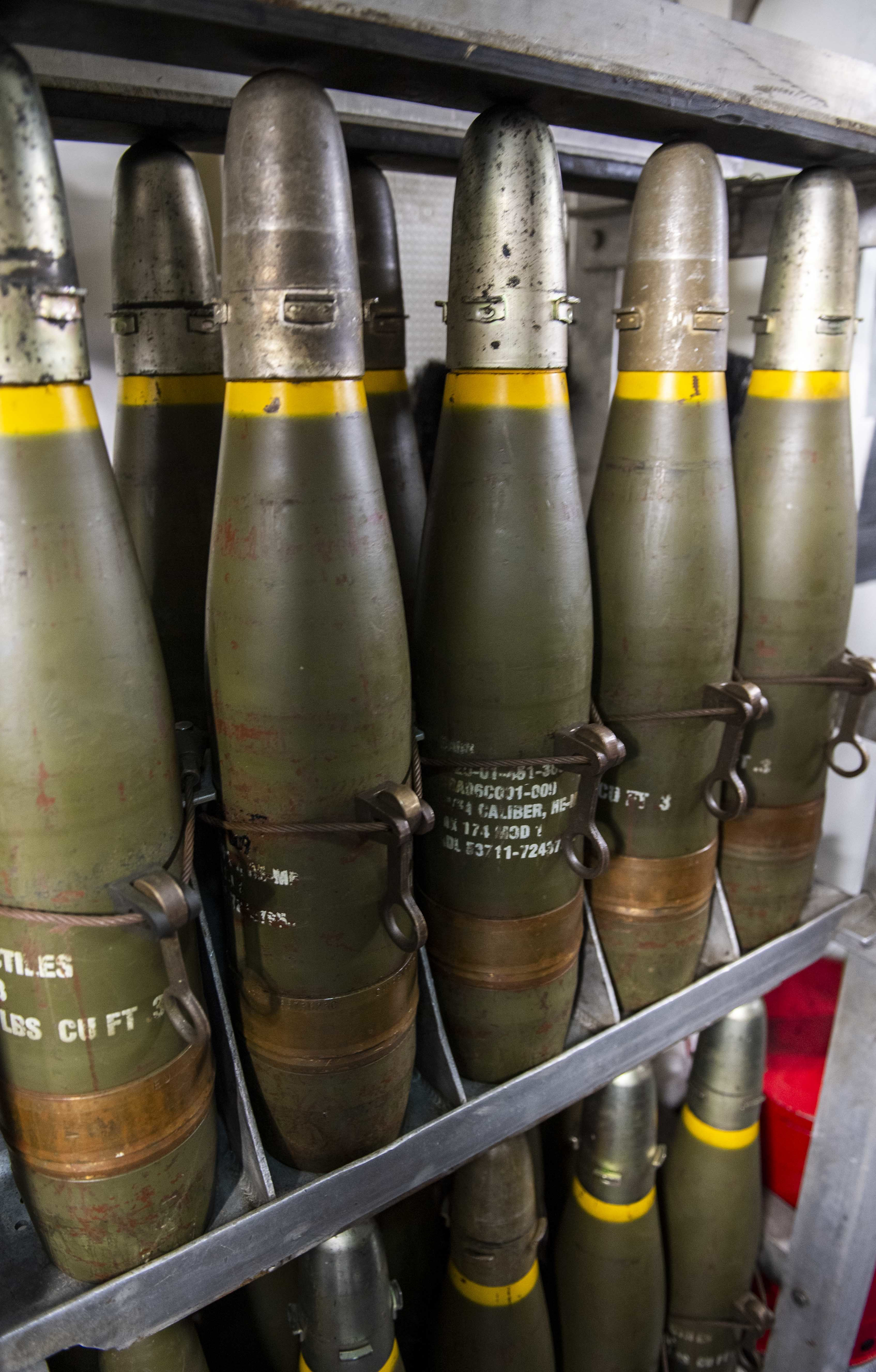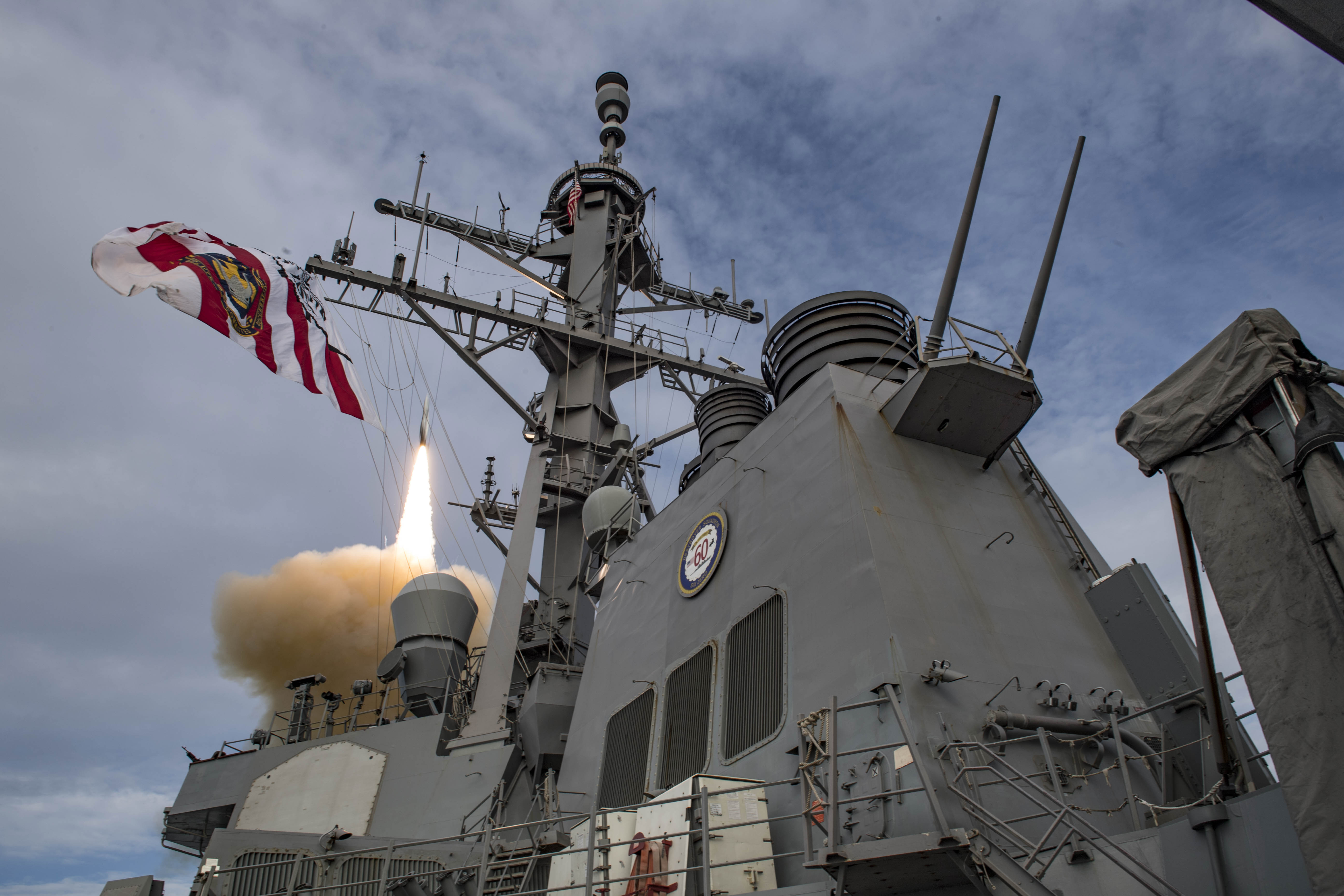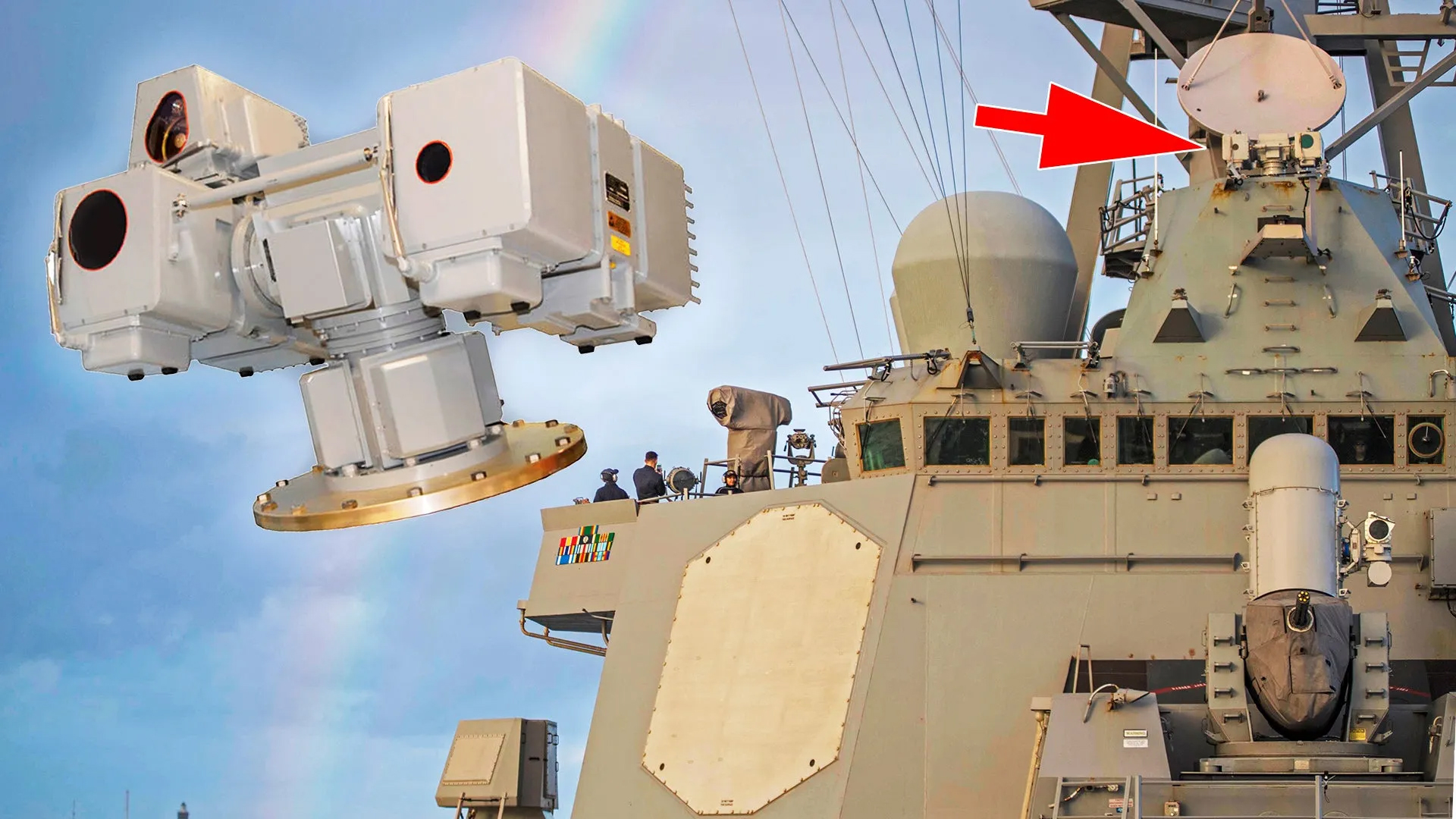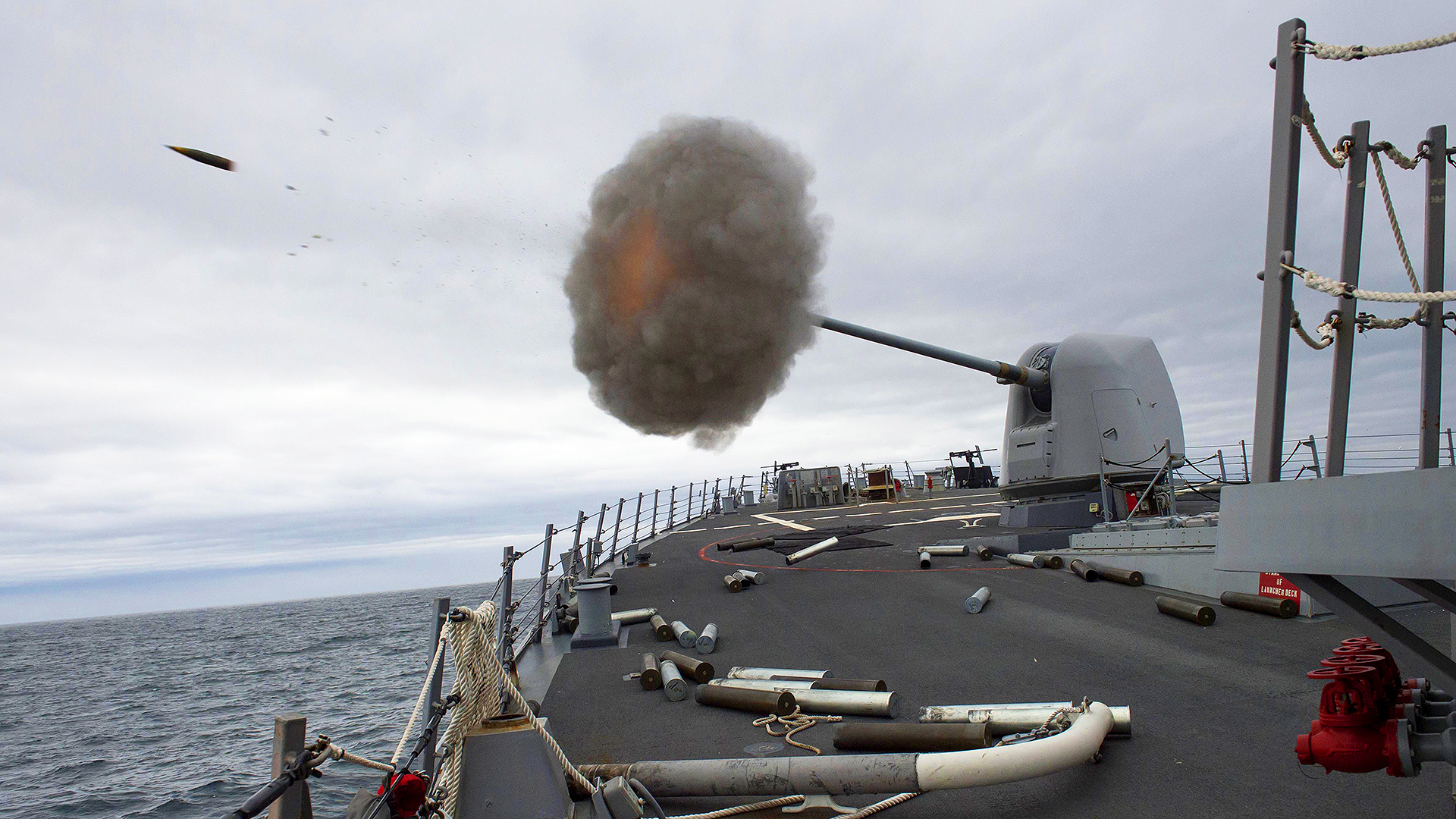As U.S. Navy destroyers continue to shoot down Iran-backed Houthi militant drone and missile barrages in the Red Sea and Gulf of Aden, a new Navy recounting of the first of those engagements, which involved the USS Carney (DDG-64), highlights a seldom discussed secondary application for the ship’s Mark 45 5-inch main deck gun — shooting down aerial threats.
On Oct. 19, 2023, Carney became the first ship to take out a Houthi missile and drone barrage fired from Yemen following Israel’s invasion of Gaza. It was the initial salvo in an ongoing fight that Navy leaders have deemed the most sustained and kinetic action the force has seen since World War II. Details have been previously reported regarding that incident and the missiles used, and other incidents have involved Navy ships leaning on their pricey missiles and even their last-resort, close-in weapon system (CIWS) to stop Houthi barrages during the past 14 months. But little has been said about destroyers using their Mark 45 5-inch main gun during such encounters, a gun normally leveled against surface and shore targets.
The Carney details released this week are admittedly short on specifics, but they feature personal insights from the sailors who were on the maritime front lines that day.

“We were in berthing and heard [an announcement over the ship’s 1MC intercom system] ‘clear the weatherdecks,’ and I remember thinking, ‘what does that mean? I’ve never heard that before,’” Fire Controlman (AEGIS) 2nd Class Justin Parker, a SPY-1 radar technician, said in the Navy release.
Parker then recalled hearing missiles and Carney’s 5-inch gun being fired.
“We had never done anything like this before – we had only trained to it,” Gunner’s Mate 1st Class Charles Currie, a technician of the Mark 45 5-inch gun, is quoted as saying. “There was a lot of adrenaline going on – this was real-world now.”
All told, Carney spent 10 hours shooting down 15 Houthi drones and four land-attack cruise missiles that day, the first of 51 combat engagements the warship would rack up before arriving back home to Mayport, Florida, in May. Their actions earned the entire crew the Combat Action Ribbon, a distinction that hadn’t been given to an entire ship’s force since the Gulf War.
Navy officials declined to clarify to TWZ what type of rounds were fired by its main gun, what they were targeting or exactly how the main deck gun was employed. Available ammunition types for the gun have included various high-explosive rounds, including proximity-fuzed air-bursting ones, and canister rounds packed with metal balls. BAE, the gun’s manufacturer, says its latest Mod 4 version can accommodate 20 conventional, semi-fixed rounds, 10 extended-length projectiles or a mixture of both in its 20-round loader drum. The ship’s entire magazine houses 600 rounds in reserve as well.

Some retired surface warfare officers say Carney’s 5-inch gun was a prime tool for taking out some of the Houthi onslaught without expending precious stocks of costly Evolved Sea Sparrow Missiles, RIM-116 Rolling Airframe Missiles (for those ships that have it) or SM-2 missiles. USNI News reported that SM-2s were used to take out the Houthi missiles in that initial October 2023 fight, but such missiles cost millions per unit, and concerns started being raised about the rate of expenditure for such munitions just a few months after that first Carney battle. By the spring of 2024, such clashes had become a near-daily occurrence.

And while we don’t yet know what kind of rounds Carney’s gun was firing that day, the Mk 45 mounted on the ship, which has a 13-nautical mile range when firing standard ammo, is capable of taking out a slower-moving aerial target like a Houthi drone.
“A (5-inch) gun can put rounds in the air, which with fragmentation can be effective air defense,” said Bradley Martin, a retired surface warfare officer and current analyst with the RAND think tank. “Against an (anti-ship cruise missile), not so much.”
Among the possible reasons for firing the gun, Carney’s leaders might have determined via flight characteristics that the Houthi ordnance were “good gun targets” that didn’t require expending costly missiles, according to Jan van Tol, a retired destroyer and amphibious assault ship captain.
“I would be a fan of that kind of approach, i.e., do not always fire at max range with your longest-range weapon, both due to high [financial cost] and having only a limited magazine of them,” van Tol, now a senior fellow with the Center for Strategic and Budgetary Assessments, told TWZ this week.

Letting a hostile drone get close enough to the ship, where the gun could be employed, could also be the result of a saturated air defense environment, where other capabilities have to be left in reserve for other threats that are being engaged or could appear at any time. The target could have also presented itself only when it was within the deck gun’s range.
TWZ has previously showcased what the Mk 45 brings to the fight and how they fire 16 to 20 rounds per minute.

Such a deck gun is also believed to have helped a Greek warship take out a Houthi drone off Somalia in July. Go here to read more about that incident.
The Mark 45 is directed via the ship’s combat systems, including the powerful “Wall-E”-looking Mark 20 Electro-Optical Sensor System (EOSS), a critical and highly flexible system that you can read more about here.
Representatives from L3Harris, the system’s manufacturer, clued TWZ in on what makes EOSS so unique during a 2019 interview:
“The primary purpose of the system is to provide highly accurate targeting information to the ship’s gun weapon system. In many instances, the ship’s radar may make an initial detection of a potential threat, and the Mk20 is then cued to visually confirm the target, and provide precise range and position for gun engagement. The goal is first shot hit accuracy. Of course, sailors are quite creative and immediately recognize the Mk20’s excellent performance as a situational awareness and navigation aid. We have heard of crews using the Mk20 to visually investigate suspicious vessels, and help navigate through congested waters. The operators find the thermal imaging capability and resolution particularly useful in nighttime operations.”

Some Navy efforts that got canceled in recent years would arguably have bolstered the 5-inch gun’s capabilities for the Houthi fight, conserving precious missiles in the process. A program that envisioned loading 5-inch guns with the speedy and versatile Hyper-Velocity Projectile (HVP) was scuttled in 2021, TWZ reported, but not before the Navy test-fired the rounds during 2018’s Rim of the Pacific (RIMPAC) exercise.
Red Sea observers and missile conservationists might be rueing that decision these days. Options like the HVP were seen as a more cost-effective and magazine-expanding way to take out a variety of threats, naval analyst and retired submarine officer Bryan Clark told USNI News in 2019.
“So if you think about the kinds of threats you might face in the Middle East, the lower-end cruise missiles or a larger UAV, now you have a way to shoot them down that doesn’t require you use a $2 million ESSM or $1 million RAM because a hyper velocity projectile – even in the highest-end estimates have it in the $75,000 to $100,000 range, and that’s for the fanciest version of it with an onboard seeker,” Clark told USNI News’ Sam Lagrone.
While the combat effectiveness of the Carney and the destroyers that have succeeded it in the Red Sea fight is undeniable, we don’t yet know the full extent of the role the humble 5-inch gun has played in these battles, or whether the Navy is once again considering giving their magazines some extra punch.
Contact the author: geoff@twz.com
